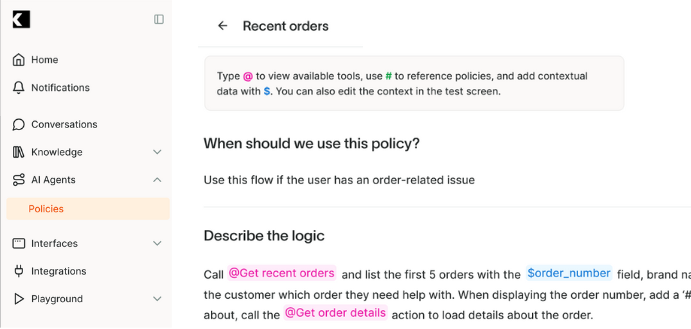Ingredients
Skio, Gladly, and Kodif.
What are AI Policies?

At Kodif, we’re excited to announce the launch of Policies—a powerful, dynamic solution designed to revolutionize the way CX managers handle customer support. Unlike traditional flows, which are rigid and complex, Policies empower non-technical users to create and manage customer interactions with ease. Written in natural language, Policies make it simple to define and refine customer experiences without needing to rely on complicated flowcharts or scripting. This approach is not only user-friendly but also self-serve, enabling CX teams to quickly translate existing Standard Operating Procedures (SOPs) into automation, saving valuable time and resources.
The flexibility of Kodif Policies ensures that businesses can offer personalized, context-driven support while continuously improving customer experiences. With Policies, you can experiment with different strategies to optimize outcomes such as CSAT, revenue, and retention—all without the need to rebuild complex workflows. Whether it’s automating routine interactions or testing new approaches for high-stakes scenarios, Policies provide a scalable, adaptable solution that aligns with your business goals. While flows still have their place in sensitive, high-risk situations, Policies offer an agile alternative that helps businesses innovate faster and deliver exceptional, tailored experiences at scale.
“Update subscription frequency” ticket type explained
In customer support, the “Update subscription frequency” ticket type refers to requests from customers who wish to change how often they receive products or services from a subscription they have. This could involve altering the delivery schedule of a product, adjusting payment intervals, or changing the frequency of a recurring service. Handling these requests efficiently is crucial as it directly affects customer satisfaction and retention. By providing a streamlined process for updating subscription frequencies, companies can enhance the customer experience, ensuring that customers receive their subscriptions according to their preferences and needs.
Which Platforms does this AI policy work on?
This AI policy is specifically designed to work on Skio, Gladly, and Kodif. However, Kodif integrates seamlessly with all other major platforms, ensuring that your customer support operations remain flexible and adaptable across various systems.
When should I use this policy?
This policy should be employed when a customer requests to update the email address associated with their account. It’s useful in scenarios where maintaining accurate customer contact information is critical for seamless communication and service delivery.
Describe the logic
Type @ to view available tools, use # to reference policies, and add contextual data with $. You can also edit the context in the test screen.
- Ask for the user’s current email address.
a. Use @get_skio_account_details to check if the provided email exists in Skio.
- Ask for the New Email Address.
a. Ask the customer to provide the new email address they want to use.
- Check for Duplicate Accounts.
a. Use @check_email_exists to verify if the new email address is already associated with another account.
b. If it is, use macro “The email address you provided is already linked to another account. Please provide a different email address or contact support for further assistance.”
- Update the Email Address in Skio.
a. Use @update_customer_email(current_email: str, new_email: str) to update the customer’s email in Skio.
b. Inform the customer that their email has been successfully updated.
Policy logic
Use this policy when a customer requests to update the email address associated with their account.
Describe the logic
Type @ to view available tools, use # to reference policies, and add contextual data with $. You can also edit the context in the test screen.
- Ask for the user’s current email address.
a. Use @get_gladly_account_details to check if the provided email exists in Gladly.
- Ask for the New Email Address.
a. Ask the customer to provide the new email address they want to use.
- Check for Duplicate Accounts.
a. Use @check_email_exists to verify if the new email address is already associated with another account.
b. If it is, use macro “The email address you provided is already linked to another account. Please provide a different email address or contact support for further assistance.”
- Update the Email Address in Gladly.
a. Use @update_customer_email(current_email: str, new_email: str) to update the customer’s email in Gladly.
b. Inform the customer that their email has been successfully updated.
Example policy
Use this policy when a customer requests to update the email address associated with their account.
Describe the logic
Type @ to view available tools, use # to reference policies, and add contextual data with $. You can also edit the context in the test screen.
- Ask for the user’s current email address.
a. Use @get_skio_account_details to check if the provided email exists in Skio.
- Ask for the New Email Address.
a. Ask the customer to provide the new email address they want to use.
- Check for Duplicate Accounts.
a. Use @check_email_exists to verify if the new email address is already associated with another account.
b. If it is, use macro “The email address you provided is already linked to another account. Please provide a different email address or contact support for further assistance.”
- Update the Email Address in Skio.
a. Use @update_customer_email(current_email: str, new_email: str) to update the customer’s email in Skio.
b. Inform the customer that their email has been successfully updated.


